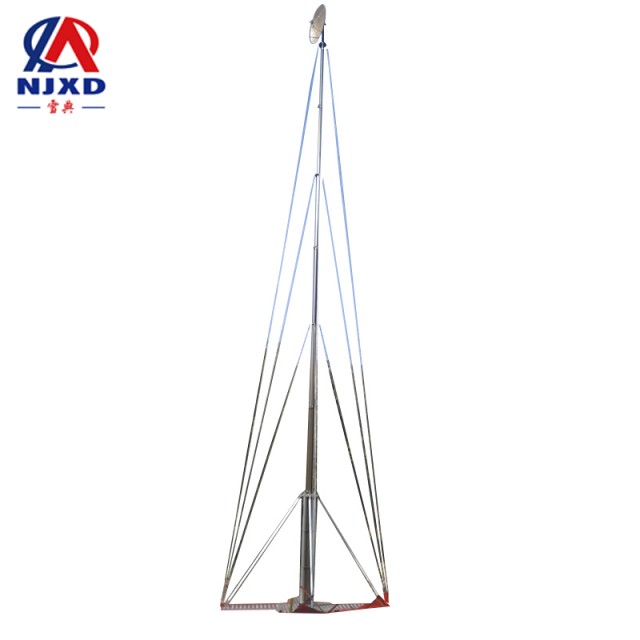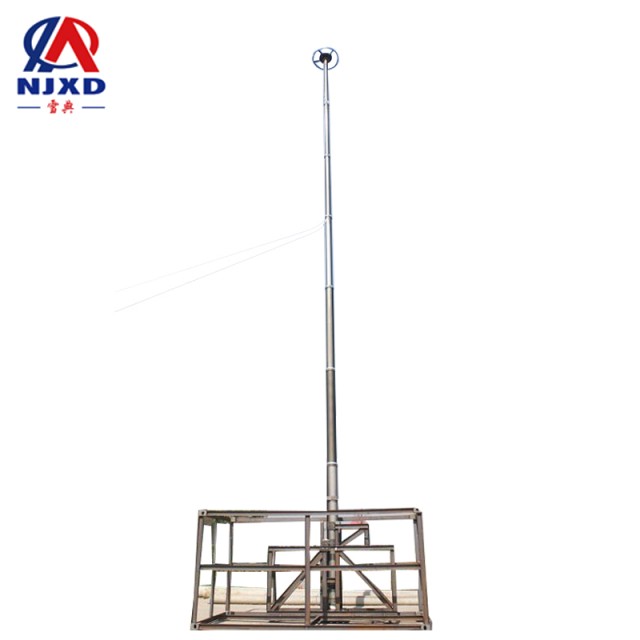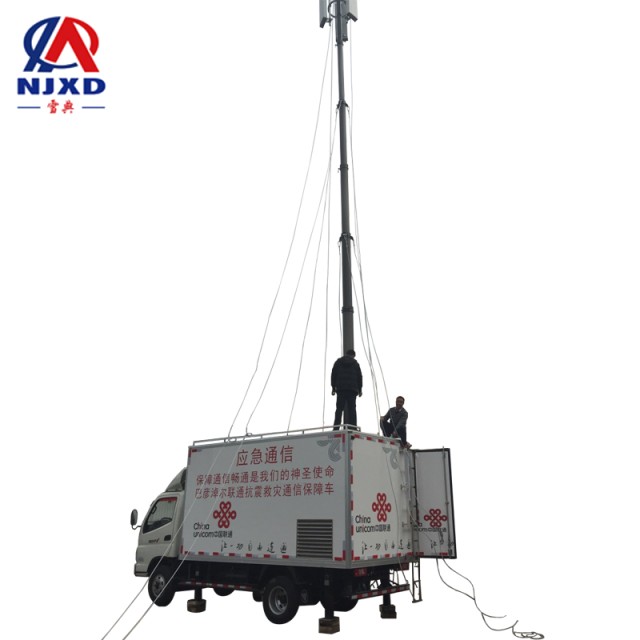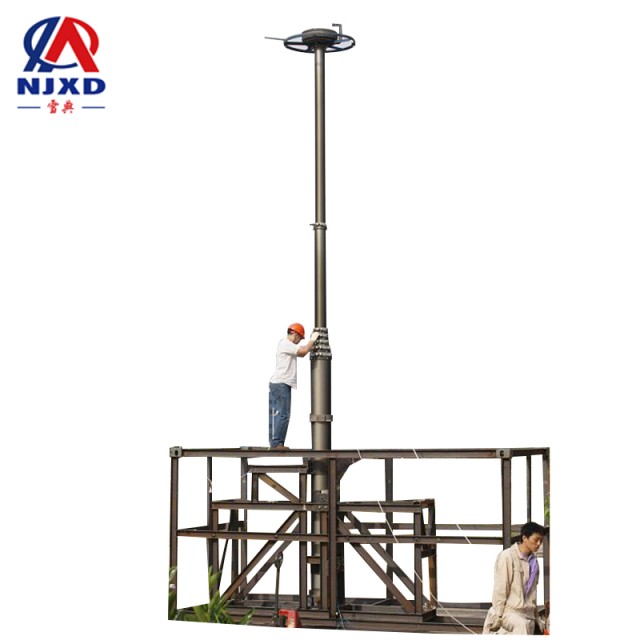NEWS
Great wind speed with lift rod wind resistance
Time:2021-08-26 View:

Maximum wind speed (extreme wind speed) the maximum instantaneous wind speed in a given period is an instantaneous value. It can be used in telescopic mast.
Introduction
Maximum wind speed refers to the maximum value of the 10-minute average wind speed in a given period of time. Maximum wind speed refers to the maximum instantaneous wind speed in a given period of time. For example, the maximum wind speed of a day is the maximum wind speed of any 10-minute average value of a day. The maximum wind speed of a day is instantaneous on this day (usually 1s) the maximum value of the wind speed. The simple point is that the maximum wind speed is an average value and the maximum wind speed is an instantaneous value. In the same specified period, the maximum wind speed is always greater than or equal to the maximum wind speed, and in most cases, the maximum wind speed is greater than the maximum wind speed.
Probability calculation
Extreme wind speed is one of the destructive meteorological factors to be considered when designing large outdoor buildings. Before carrying out the design, engineers and technicians must investigate the occurrence rules of the maximum wind speed on different local height layers, calculate the maximum wind speed in each reproduction interval year, for example, the great wind speed once in a hundred years or the great wind speed once in a thousand years, then determine the windproof standard of the building, and then carry out other work. For example, railway bridges and culverts are generally considered to bear the impact of the local 20-meter-high wind in 100 years, and overhead transmission lines should consider the impact of the local strong wind in 15 years, this work is actually a process of calculating the probability of disastrous extremely strong winds and then taking preventive measures.
Statistical analysis of Geng Bell Model
Analyze the occurrence rule of the maximum wind speed in different height layers of a certain place, calculate the maximum wind speed in each reproduction interval year, and only need to analyze the long time of a local height layer (more than 30 years) series of annual maximum wind speed data, get the distribution law of Geng Bell, then calculate the maximum wind speed of each reproduction interval year, and deduce the maximum wind speed of each reproduction interval year of other local height layers.
Steps:
The relationship between the maximum wind speed of 10min and the maximum wind speed of 2min is analyzed by using the self-recorded data of electric wind connection. According to the analysis results, the maximum wind speed of 2min in history is converted into the maximum wind speed of 10min, get a long series of annual maximum wind speed;
Using extreme statistical theory (Geng Bell distribution function) to analyze the annual series data of the maximum wind speed of the selected meteorological station, and calculate the maximum wind speed of each reproduction interval year;
Based on the data of annual extremely strong wind and the highest wind accumulated by nearby automatic stations, this paper analyzes the relationship between the local extremely strong wind and the local extremely strong wind. According to the analysis results and the calculation results of the maximum wind speed in each reproduction interval year, the maximum wind speed of each reproduction interval year of 10m height layer is deduced;
According to the requirements of engineering design, the maximum wind speed of each reproduction interval year of 10m height layer is deduced according to power law formula to the maximum wind speed of each reproduction interval year of the height layer.

Maximum wind speed estimation of wind farm
The maximum and maximum wind speed of a wind farm in 50 years is the key index that determines the ultimate load of wind turbine, and it is also one of the key indexes of machine group selection and economic evaluation in the development of wind power projects.
The maximum wind speed of a wind farm in 50 years usually refers to the average wind speed of 10 min, and the maximum wind speed in 50 years usually refers to the average wind speed of 3s. Maximum wind speed is an important index to determine whether the wind turbine can survive safely in the wind farm. According to the requirements of relevant standards, the design life of wind turbine should be more than 20 years, and the design standard of maximum wind speed should be once every 50 years, that is, the survival wind speed of the wind turbine designed in 50 years should be greater than that of the wind farm in 50 years.
People have developed a set of methods to calculate the 50-year extreme wind speed of the wind farm by using the correlation between the long-term weather station and the wind farm, which has been widely recognized.
The calculation is mainly divided into several steps:
(1) using Gumbel to calculate the frequency, and using the data of the maximum wind speed of the weather station for many years, the maximum wind speed of the weather station l0m high once in 50 years is obtained;
(2) using the correlation between weather station and wind speed of wind farm to calculate the designed maximum wind speed of wind farm 10 m high and 50 years;
(3) calculate the designed maximum wind speed at the height of the hub once every 50 years by using the relationship between 70 m and 10 111 high wind shear of the wind tower;
(4) Finally, according to the gust coefficient (generally 1.4), the design maximum wind speed at the hub height for 50 years is obtained and converted to the standard air density condition.

Case
Northern Jiangsu was hit by a tornado with a maximum wind speed of 22.1 m/s.
On the afternoon of June 23, 2016, Northern Jiangsu suffered extreme severe convective weather. Huai'an Lianshui County and Yancheng Binhai County suffered heavy rain, and Fuling County experienced hail and Tornado. Tornadoes caused crushing damage to brick houses, twisted steel frames, swept away car quilt, and casualties. At present, local rescue is being organized.
At about 2:30 p.m. on June 23, 2016, severe convective weather such as strong lightning, short-term rainfall, hail, thunderstorm and strong wind occurred in some areas of Yancheng Funing and Sheyang, which were affected by Hook echo, 34.6 m/s (Level 12) Gale appeared in Xingou town and other places in Funing county, 27.9 m/s (level 10) Gale appeared in Sheyang Haihe town and other places, causing house collapse, casualties, disasters such as blocked roads and damaged facilities and agriculture. According to preliminary statistics, as of 22:00 on the 23rd, 78 people had died, nearly 500 were injured and nearly 200 were seriously injured. The specific disaster situation was being further verified and rescue was being organized locally.
On September 14, 2016, according to the Fujian news broadcast report, the National Ocean News desk reported: In the process of "Meranti" wiping the south of Taiwan, the wave heights (effective wave heights) of 17 meters were observed in the two buoys of ngoluanpi and small Ryukyu at 9 and 12 today respectively, which is the highest historical observation record of China's offshore HAILANG. The Central Meteorological Observatory continued to issue a red typhoon warning at 18:00 on the 14th. This morning, Typhoon Meranti, the 14th of this year, measured an average wind force of 85 m/s per minute, and the gust reached more than 100 m/s, far exceeding the speed of the Beijing-Shanghai high-speed railway. It is estimated that Meranti will move to the northwest at a speed of about 20 kilometers per hour and will land on the coast of Hui'an, Fujian province to Qian'an in the early morning of the 15th.
